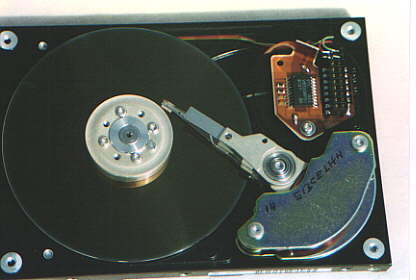MASS STORAGE DEVICES |
A mass storage device is one that can store a large quantity of informations as bits.
Chief amongst these are hard disks. These are flat and rigid rotating disks covered on one or both sides with some magnetisable material. Informations can be written to it or read from it via an arm (see photograph) whose head is sensitive to magnetic fields of minute areas at the surface of the disk. Of course electronic circuits (partially visible on the photograph) are needed to accomplish this and to control the disk. The whole unit is called a hard disk drive, disk drive or simply a drive. It can contain tens of gigabytes (a gigabyte is a billion of bytes. That is where are recorded all files you are creating when you record texts you have typed on the keyboard. They also contain lots of programs which are recorded as files and which are necessary to the operation of the system.
 |
These disks are spinning at a rate of about 5 to 10,000 rpm (revolutions per minute) and according to the position of the arm one can have a fast access to any area of the disk. 10,000 rpm means 3/1000 second for a half revolution which gives an idea of the average time necessary to get at the geographical position of a bit on the disk. And that is still quite slow for a processor...
The floppy disk drive allows to record and read informations on a floppy disk. Floppy disks can usually only hold 1.44 megabytes. Further they are not very reliable and their lifetime is usually not very high. Their advantage is that they are handy to transport small amounts of informations.
The CD-ROM drive can read information on a CD-ROM, which can hold about 700 megabytes. If it's a burner it can also record informations on recordable or rewritable CDs (see "CD-R" and "CD-RW" in the glossary as needed). Music is recorded as bits and it can be restored by the drive which sends bits to the computer and this one converts the data into electrical impulses which make the baffles vibrate.
CD is an acronym for Compact Disc. ROM is for Read Only Memory.
The DVD drive is the same for pictures. The acronym DVD was originally for Digital Video Disc, then Digital Versatile Disc. A DVD can contain 133 minutes of movie along with the sound recording.
| |
|
| Copyright 2003-2004 Jacques Lederer |
